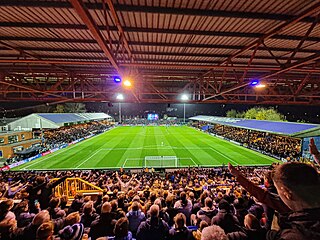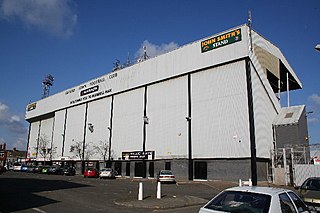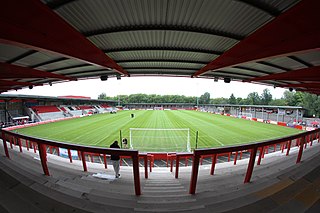Related Research Articles

Omagh is the county town of County Tyrone, Northern Ireland. It is situated where the rivers Drumragh and Camowen meet to form the Strule. Northern Ireland's capital city, Belfast, is 68 miles (109.5 km) to the east of Omagh, and Derry is 34 miles (55 km) to the north.

Anfield is a football stadium in Anfield, Liverpool, Merseyside, England, which has a seating capacity of 53,394, making it the seventh largest football stadium in England. It has been the home of Liverpool F.C. since their formation in 1892. It was originally the home of Everton from 1884 to 1891, before they moved to Goodison Park after a dispute with the club president.

Lansdowne Road Stadium was a stadium in Dublin owned by the Irish Rugby Football Union (IRFU) that was primarily used for rugby union and association football matches. The stadium was demolished in 2007 to make way for the Aviva Stadium on the same site, which opened in 2010.

Edgeley Park is a football stadium in Edgeley, Stockport, England. Built for rugby league club Stockport RFC in 1891, by 1903, the rugby club was defunct and Stockport County Football Club moved in. The ground is set to be increased to a capacity of around 19900 with the start of the project in 2023.

Goodison Park is a football stadium in the Walton area of Liverpool, England, 2 miles (3 km) north of the city centre. It has been the home of Premier League club Everton since 1892 and has an all-seated capacity of 39,414.

Maine Road was a football stadium in Moss Side, Manchester, England, that was home to Manchester City F.C. from 1923 to 2003. It hosted FA Cup semi-finals, the Charity Shield, a League Cup final and England matches. Maine Road's highest attendance of 84,569 was set in 1934 at an FA Cup sixth round match between Manchester City and Stoke City, a record for an English club ground.

St James' Park is a football stadium in Newcastle upon Tyne, England. It is the home of Premier League club Newcastle United F.C. With a seating capacity of 52,305 seats, it is the eighth largest football stadium in England.

The Dell on Milton Road, Southampton, Hampshire, England was the home ground of Southampton F.C. between 1898 and 2001.

White Hart Lane was a football stadium in Tottenham, North London and the home of Tottenham Hotspur Football Club from 1899 to 2017. Its capacity varied over the years; when changed to all-seater it had a capacity of 36,284. The stadium was fully demolished after the end of the 2016–17 season.

McDiarmid Park is a stadium in Perth, Scotland, used mainly for association football. It has been the home ground of Scottish Premiership side St Johnstone since its opening in 1989. The stadium has an all-seated capacity of 10,696.

Home Park is a football stadium in Plymouth, England. The ground has been the home of Football League One club Plymouth Argyle since 1901.

Healy Park is a GAA stadium in Omagh, County Tyrone, Northern Ireland and is named after a GAA clubman from Omagh, Michael Healy.

Blundell Park is a football ground in Cleethorpes, North East Lincolnshire, England and home to Grimsby Town Football Club. The stadium was built in 1899, but only one of the original stands remains. The current capacity of the ground is 9,052, after being made all-seater in summer 1995, reducing the number from around 27,000. Several relegations in previous years meant the expansion seating was also taken away; that reduced the capacity further from around 12,000 to what it is now.

Knowsley Road in Eccleston, St Helens, Merseyside, was the home ground of St. Helens from 1890 until its closure in 2010. St Helens Town FC played their home fixtures at Knowsley Road from 2002 until 2010. For a period, the venue also hosted Liverpool F.C. Reserves. The stadium was demolished during spring 2011 and a new construction then known as Cunningham Grange, named after club legend Keiron Cunningham, was built on the site.

Haig Avenue is a football stadium in Blowick, Southport, Merseyside, England, that holds 6,008 people Since its opening in 1905 it has been the home ground of Southport F.C. Everton Reserves also use the stadium for home games.

The Kirkby Project was a proposed new football stadium in Kirkby, England for Everton. The stadium, if built, would have replaced Goodison Park as Everton's home ground. The plan originated in 2006, was the subject of a Public Inquiry in December 2008, but was eventually rejected by central government in November 2009. The stadium had a planned all-seated capacity of 50,401 with a provision to be expanded to 60,000.

Leeds Road was a football stadium in Huddersfield, England. It operated from its construction in 1908 until the Kirklees Stadium was opened nearby for the 1994–95 season. It was the home of Huddersfield Town A.F.C. from 1908 to 1994 and was also the base for Huddersfield RLFC from 1992 to 1994.
A large number of English football clubs have ongoing schemes to redevelop existing grounds, or to move to newly constructed stadiums. A trend towards all-seater stadiums was initially prescribed by the Taylor Report, and was originally a condition only of Premier League admission. It has now become a requirement that within three years of a club's first promotion to the Championship all paying spectators are seated, even if the club is subsequently relegated. This page provides an (incomplete) list and description of those clubs who have planned new stadiums or refurbishments, or who have already moved/refurbished since around the time of the Taylor Report.

Broadhurst Park is a football ground in Moston, Manchester, England. It is the home of F.C. United of Manchester and Moston Juniors F.C. The ground was known by its project name, Moston Community Stadium, before being changed at a members' meeting in 2014.
Old Road Ground, also known as the Clacton Greyhound Stadium, was a cricket, football, and greyhound racing stadium in Clacton-on-Sea, Essex.
References
- 1 2 Details for St Julians Road, Omagh
- ↑ Still no place for gaelic games in NI state school sector
- ↑ Manchester United set for match at Omagh
- ↑ Omagh Town 0 Manchester United 9
- ↑ FOOTBALL: HOULLIER CHOOSES FROM A FULL-STRENGTH POOL; Omagh Town v Liverpool
- ↑ Proposal to redevelop St Julian's Road ground to go before council